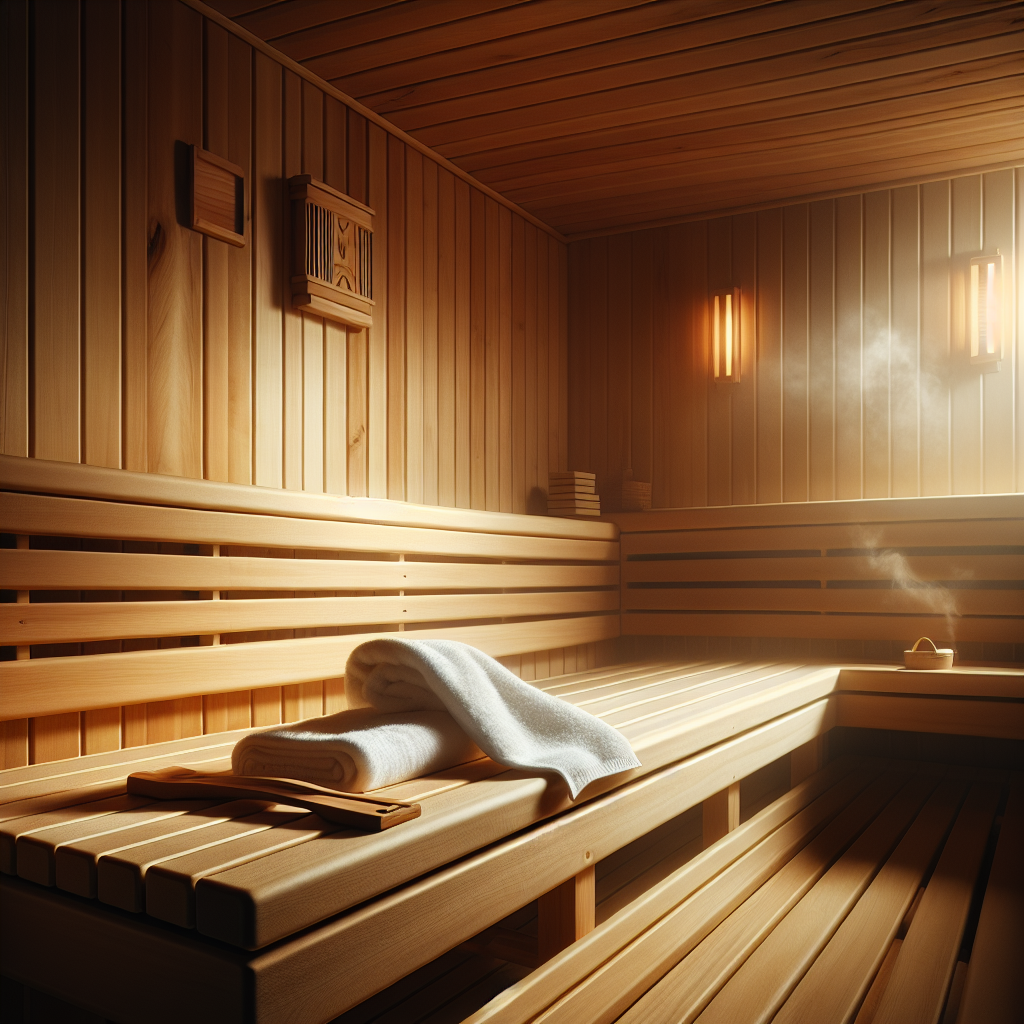Find out the optimal position to reap the utmost benefits during your sauna session. Whether you prefer to sit or lie down, understanding how to position yourself properly can enhance the overall experience. Discover the most effective way to sit or lie in a sauna to maximize your relaxation, detoxification, and rejuvenation.

The Benefits of Sauna
The sauna has been used for centuries as a way to relax and rejuvenate the body. It offers numerous health benefits that can improve your overall well-being and leave you feeling refreshed. Let’s explore some of the benefits of using a sauna.
Detoxification
One of the major benefits of sauna use is detoxification. When you sit in a sauna, your body sweats, which helps to eliminate toxins and impurities from your system. The high heat of the sauna causes your pores to open up, allowing the sweat to easily flow out and carry away toxins. This process can leave you feeling cleansed and revitalized.
Improved Circulation
Using a sauna can also improve circulation throughout your body. The high heat causes your blood vessels to expand, allowing blood to flow more freely. Improved circulation can have numerous positive effects on your body, such as reducing muscle tension, promoting healing, and even enhancing mental performance.
Enhanced Skin Health
Sauna use can do wonders for your skin. The combination of high heat and sweating helps to unclog pores and remove dead skin cells, leaving your skin looking and feeling healthier. Additionally, the improved circulation can promote a healthy glow and even reduce the appearance of fine lines and wrinkles.
Stress Relief
Perhaps one of the most well-known benefits of sauna use is stress relief. The sauna provides a soothing and peaceful environment where you can relax and unwind. The heat and humidity of the sauna can help to relax your muscles, release tension, and calm your mind. Spending time in a sauna can be a great way to relieve stress and promote a sense of relaxation and well-being.
Understanding the Sauna Environment
To fully enjoy the benefits of a sauna, it’s important to understand the unique environment it creates.
High Temperature
Saunas are known for their high temperatures, usually ranging from 150°F to 190°F. The intense heat is what helps to stimulate sweating and promote detoxification. However, it’s essential to listen to your body and not stay in the sauna for longer than is comfortable for you.
Low Humidity
Saunas also have low humidity levels, typically ranging from 10% to 20%. The low humidity allows sweat to evaporate quickly, cooling your body and preventing you from feeling suffocated by the heat. The combination of high temperature and low humidity creates a unique and invigorating environment.
Infrared Saunas
In addition to traditional saunas, there are also infrared saunas available. These saunas use infrared heaters to emit radiant heat, which penetrates the skin more deeply than the heat from traditional saunas. Infrared saunas are often preferred by those who find the intense heat of traditional saunas uncomfortable.
General Guidelines for Sauna Use
To make the most of your sauna experience, it’s important to follow some general guidelines.
Consulting a Healthcare Professional
Before starting sauna sessions, it’s always a good idea to consult with a healthcare professional, especially if you have any underlying health conditions or concerns. They can provide guidance on the frequency and duration of sauna use that is appropriate for your specific situation.
Ensuring Proper Hydration
Sitting in a sauna can cause you to sweat profusely, leading to loss of both water and electrolytes. It’s crucial to stay hydrated before, during, and after sauna sessions. Drinking water or an electrolyte-rich beverage before and after your sauna session can help replenish lost fluids and prevent dehydration.
Avoiding Alcohol and Drugs
It’s recommended to avoid alcohol and drugs before using a sauna. Alcohol can impair your body’s ability to regulate temperature and can potentially lead to dangerous situations in high-heat environments. Additionally, using drugs in the sauna can pose serious health risks and should be avoided.
Eating Lightly Before Using the Sauna
To avoid discomfort, it’s best to eat lightly before going into a sauna. A heavy meal can make you feel sluggish and uncomfortable in the heat. Opt for a light snack or meal that will provide you with energy without weighing you down.
Sitting Positions in the Sauna
Finding the right sitting position in the sauna can enhance your comfort and maximize the benefits of your session.
Traditional Sitting Position
The traditional sitting position involves sitting upright on the sauna bench, with your back against the wall. This position allows for better airflow and heat distribution, ensuring that your whole body gets exposed to the sauna’s heat evenly.
Lounge Sitting Position
The lounge sitting position is another popular option in the sauna. Instead of sitting upright, you can lean back and relax, extending your legs on the bench. This position allows for a more laid-back and comfortable experience, perfect for longer sauna sessions.

Lying Positions in the Sauna
If you prefer a more relaxed sauna experience, lying down can be an excellent option. Here are some lying positions you can try in the sauna.
Straight Lying Position
In the straight lying position, you lie flat on your back on the sauna bench, with your legs extended and your arms at your sides. This position allows for full body contact with the bench, facilitating optimal heat transfer and relaxation.
Bent Legs Lying Position
The bent legs lying position involves lying on your back with your legs bent at the knees. You can position your feet on the bench or rest them against the wall for added comfort. This position can relieve tension in the lower back and thighs.
Extended Legs Lying Position
In the extended legs lying position, you lie on your back with your legs extended fully, similar to the straight lying position. However, instead of resting your feet on the bench, you extend them beyond the bench’s edge, allowing your feet to cool down slightly if desired.
Using Towels or Mats
Using towels or mats can enhance your comfort and hygiene during sauna sessions.
Placing a Towel on the Bench
To create a barrier between your body and the bench, it’s common practice to place a towel on the bench before sitting or lying down. This helps absorb sweat and prevent direct contact with the hot surface, making your sauna experience more comfortable and hygienic.
Using a Sauna Mat
If you prefer additional cushioning, you can use a sauna mat on top of the towel. Sauna mats are typically made of heat-resistant materials and provide extra support and comfort during your sauna session.
Incorporating Movement and Stretching
While the primary purpose of using a sauna is relaxation, incorporating gentle movement and stretching can further enhance your experience.
Gentle Stretches
Performing gentle stretches in the sauna can help relieve muscle tension and improve flexibility. Focus on simple stretches that target major muscle groups, such as neck rolls, shoulder stretches, and leg stretches.
Rotation Exercises
Rotation exercises involve rotating your joints in a circular motion. This can help improve flexibility and increase joint mobility. You can perform rotation exercises for your shoulders, wrists, ankles, and neck while in the sauna.
Leg Exercises
If space allows, you can also perform light leg exercises in the sauna, such as leg lifts or ankle rotations. These exercises can help improve circulation in your legs and prevent stiffness.
Sauna Etiquette
When using a public sauna, it’s essential to follow proper sauna etiquette to ensure a positive and respectful experience for everyone.
Considerate Use of Space and Time
Be mindful of the space and avoid hogging the sauna for an extended period. Respect the sauna’s seating capacity and give others a chance to enjoy the benefits as well. Keep conversations quiet and be mindful of others’ relaxation.
Covering the Body
While nudity can be common in some sauna cultures, it’s essential to respect the rules and expectations of the specific sauna you are using. If required, use a towel to cover your body for modesty and hygiene purposes.
Using a Towel
Using a towel is a common practice in saunas to ensure hygiene and cleanliness. It’s customary to sit or lie on a towel to prevent direct contact with the bench or mats. Additionally, use a towel to wipe away excess sweat to maintain cleanliness.
Precautions and Safety Measures
To enjoy the sauna safely, it’s important to consider certain precautions and safety measures.
Monitoring Time and Temperature
While saunas offer numerous benefits, it’s crucial not to overdo it. Monitor the time you spend in the sauna and ensure that the temperature is within a comfortable range for your body. Respect your body’s limits and exit the sauna if you feel lightheaded, dizzy, or unwell.
Listening to Your Body
Your body knows best, so pay attention to any discomfort or signs of fatigue during your sauna session. If you feel overheated or uncomfortable, take a break, step out of the sauna, and cool down. Always prioritize your well-being and comfort.
Pregnancy and Sauna Use
Pregnant women should exercise caution when using saunas. High temperatures can affect fetal development, and the increased heart rate from sauna use may pose risks. It’s best to consult with a healthcare professional before using a sauna during pregnancy.
Certain Medical Conditions and Sauna Use
If you have underlying medical conditions such as cardiovascular problems, respiratory issues, or skin disorders, it’s crucial to consult with a healthcare professional before using a sauna. They can provide guidance on whether sauna use is safe and suitable for your specific condition.
Personal Preferences and Experimentation
Finding the best sitting or lying position in the sauna is a personal endeavor. It’s essential to listen to your body and experiment with different positions to find what works best for you.
Finding Your Ideal Position
Everyone’s body is different, so it’s important to find the position that gives you the most comfort and relaxation. Experiment with different sitting and lying positions to determine what feels best for your body and provides maximum benefit.
Trying Different Positions
Don’t be afraid to try different positions during your sauna session. You may find that you prefer one position for a certain amount of time and then switch to another for variety. Mix it up and see what feels most enjoyable for you.
Listening to Your Comfort Level
Ultimately, your comfort is paramount when using a sauna. If a particular position feels uncomfortable or causes any pain, adjust or change your position. Listen to your body’s signals and prioritize your well-being throughout your sauna experience.
In conclusion, the sauna offers a myriad of benefits, from detoxification and improved circulation to enhanced skin health and stress relief. By understanding the sauna environment, following general guidelines for sauna use, and experimenting with various sitting and lying positions, you can maximize your sauna experience. Remember to prioritize your well-being, listen to your body, and enjoy the relaxation and rejuvenation that saunas provide.

